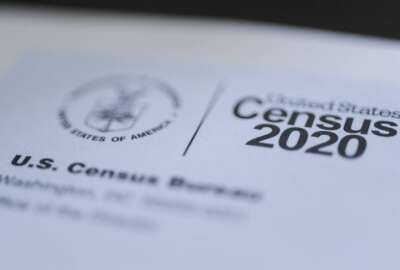Hubbard Radio Washington DC, LLC. All rights reserved. This website is not intended for users located within the European Economic Area.
On Air: Federal News Network
Trending:
Government shutdown cost feds 6.6 million days of work
The 16-day government shutdown forced federal employees to miss millions of days of work, agencies to forego millions of dollars in revenue and programs to grin...
wfedstaff | April 17, 2015 5:47 pm
The 16-day government shutdown forced federal employees to miss millions of days of work, agencies to forego millions of dollars in revenue and programs to grind to a halt.
In a new report issued Thursday, the Office of Management and Budget estimated both the economic, programmatic and budgetary costs of the longest closing of government since 1995.
OMB estimates that federal workers missed 6.6 million days of work and the shutdown cost more than $2.5 billion in lost productivity and pay and benefits for employees, most of which didn’t work.
OMB Director Sylvia Mathews Burwell said that $2.5 billion is one of the biggest measurements used to signify the impact of the shutdown. “Overall, federal agencies furloughed roughly 850,000 employees per day in the immediate aftermath of the lapse in appropriations, or roughly 40 percent of the entire civilian federal workforce,” the report stated. “Those employees that were not furloughed were retained either because they were performing activities that are ‘excepted’ under the applicable legal requirements (such as activities necessary to maintain the safety of life or the protection of property), or because funding remained available to pay their salaries and expenses during the lapse from sources other than annual appropriations.”
The Defense Department lost the most days, 1.6 million, followed by the departments of Treasury (985,000), Agriculture (737,000) and Interior (646,000).
Burwell said OMB used a formulaic approach to figure out the costs. Agencies submitted the number of employees under furlough and OMB multiplied it by the average salary by agency to get the total 2.5 billion dollar figure.
“The other thing this does not cover is the issue of all the preparation leading up to and what happens post [shutdown],” Burwell said Thursday during a briefing with reporters. “As I’m sure you can imagine, there was a lot of preparation that went into taking care of preparing for the shutdown and actually doing the shutdown, so those were thousands and thousands of man hours across all the agencies and departments, and as we moved to reopen things, we had those costs too.”
She added the report also tried to detail the impact on the workforce in the short term and long term in terms of recruitment and retention. OMB stated the shutdown and sequestration-relate furloughs undermine the competitive advantage the government has in hiring workers.
OMB’s report also details lost revenue among agencies, such as the Smithsonian, which is estimated to have missed out on $4 million in additional revenue, and the National Park Service, which missed out on $7 million in revenue as well. The IRS couldn’t collect $2 billion in taxes, and the Social Security Administration delayed completing 1,600 medical disability reviews and 10,000 Supplemental Security Income redeterminations.
She said the National Science Foundation had to put basic research on hold because it furloughed 98 percent of the staff.
“To give you a sense of that, on average NSF issues about 765 grants and continuations in a two-week period so you can get a sense of the magnitude of something like that from a programmatic sense,” Burwell said. “The other thing I want to highlight is the other direct budgetary costs. That came in things like uncollected fees at national parks. The National Park Service estimated that it was unable to collect about $450,000 a day.”
The federal government also had to pay additional interest on payments that were late because of the shutdown under the Prompt Payment and Cash Management Improvement acts, Burwell added.
Burwell said programs didn’t bounce back right away either. It took more than a week to restore normal operations at the National Nuclear Security Administration, and it could take more than a week to restore operations at some Energy Department labs and plants, where they also lost three weeks of mission work.
Burwell said the report shows that there are a number of negative ramifications because of the shutdown, including on the economy and government efficiency.
“The impacts that occurred because of programmatic things that were occurring that affect people’s daily lives whether those are their economic lives or their personal lives,” she said. “By doing the report, [we wanted to] make sure there was clarity about that.”
And it’s not just federal employees not being at work that cost the government. OMB estimated that 10,000 contractors faced stop work orders and temporary layoffs. And those stop work orders could cost the government additional millions of dollars.
“Federal acquisition regulations allow contractors to request equitable adjustments for certain cost impacts associated with having to put operations on hold (e.g., costs of maintaining idle facilities, unabsorbed overhead),” the report stated. “There could be thousands of requests from contractors seeking to be reimbursed for costs incurred as a result of these suspensions.”
Additionally, because Congress didn’t pass an appropriations bill and forced agencies to close, millions of Americans did not receive critical services during the shutdown, including inspections by the Food and Drug Administration and the Environmental Protection Agency. The National Transportation Safety Board was not able to perform timely inspections of airplane crashes and the National Institutes of Health was unable to enroll patients in clinical trials, OMB stated.
OMB developed this report for several reasons. The first of which is lawmakers requested it. In a letter to OMB on Oct. 23, Sen. Barbara Mikulski (D-Md.) asked the administration to document the consequences of the 16-day closure.
“This type of report also was done post the 1995-96 shutdown by John Koskinen. In terms of the follow up and closing down the issues of shutdown, we believed it was important to have in one place the articulated impact,” Burwell said. “One thing that did come out of the shutdown is a greater appreciation for a number of things the government did, and many of the stories helped people understand some of the things that were being interrupted.”
Burwell added OMB sent the report to Mikulski.
Sen. Mark Warner (D-Va.) also requested in late October that the Government Accountability Office to analyze the costs of the shutdown.
Warner asked the GAO to look at the shutdown’s impact on the overall economy, the federal workforce, federal agency operations, state and local governments, federal contractors and other private sector businesses, and lost tax and fee revenue.
Mikulski issued a statement Thursday about the report saying it is further proof that the shutdown hurt the economy and cost jobs.
She said her goal is for the bicameral budget conference to come to a deal that cancels the sequester for two years and provides topline funding numbers for both 2014 and 2015, making it possible for the Appropriations Committee to enact a 12- bill Omnibus bill by Jan. 15 that funds the government for the rest of 2014.
Sen. Tom Carper (D-Del.), chairman of the Homeland Security and Governmental Affairs Committee, said in a statement that Congress must figure out how to compromise and lead.
“Despite the setbacks we face in light of October’s shutdown, I remain eternally optimistic that our upcoming budget negotiations will yield an agreement that puts our nation on a financially responsible path and restores the faith of the American people,” he said. “I hope this report reinforces our understanding of the deep and harmful impact the shutdown had on our nation and economy and helps bring this irresponsible behavior to an end.”
The American Federation of Government Employees President J. David Cox said in a statement that the report showed the detrimental consequences of the shutdown.
Cox says he hopes “all lawmakers keep a copy of OMB’s report by their side as they engage in other budget debates. They all need to remember that putting vital government services at risk to score political points is a costly exercise that has ruinous consequences for our government and the country.”
National Treasury Employees Union President Colleen Kelley said in a statement the report demonstrates the severe and needless damage done by Congress’ inability to perform its most basic duties.
“Those who used federal employees as political pawns and shut down the government to try and score political points need to be held accountable, and responsible members of Congress need to make sure it does not happen again,” she said.
Read Federal News Radio’s full coverage of the government shutdown here.
RELATED STORIES:
After the shutdown: Federal employees cite drain on morale (Federal News Radio)
Pentagon says shutdown wasted at least $600 million (Federal News Radio)
Copyright © 2024 Federal News Network. All rights reserved. This website is not intended for users located within the European Economic Area.
Jason Miller
Jason Miller is executive editor of Federal News Network and directs news coverage on the people, policy and programs of the federal government.
Follow @jmillerWFED





